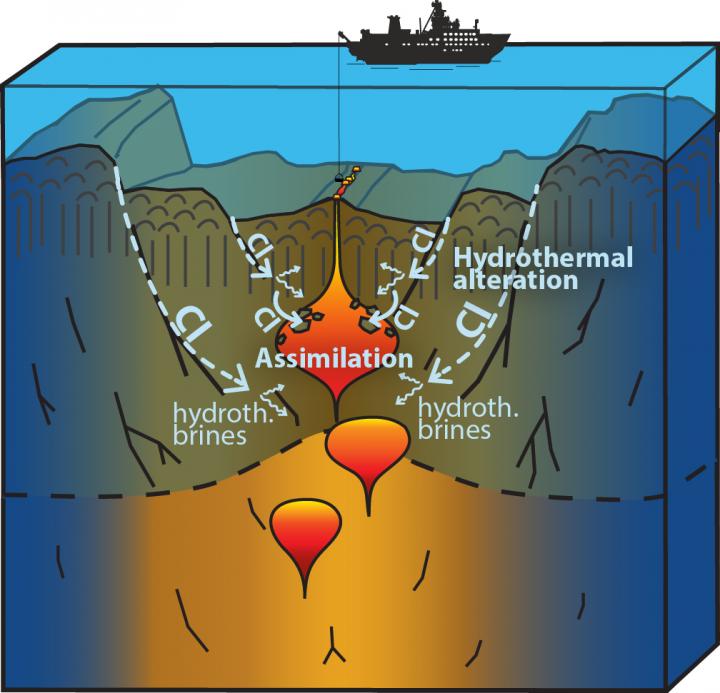Water cooling for the Earth's crust

The hydrothermal circulation changes the ocean crust and increases the Chlorine (CL) concentration of the rocks by incorporation of sea water. The magma takes up parts of this crust leading to an increase of chlorine of the magma. If the magma erupts at the sea floor, basalt lava is formed that we sampled and investigated in detail. Credit: GEOMAR Usage Restrictions: Usage only in the context of this press release
Hot vents in the deep sea and geysers on land document the penetration of water into the hot interior of the Earth. This happens primarily in regions where the crust breaks up and magma chambers are close to the surface, e.g. in the area of mid-ocean ridges.
But how deep does the water penetrate and cool the upper part of the hot mantle? So far it has been assumed that this process only reaches depths of a few kilometres. A new analytical method, developed at GEOMAR Helmholtz Centre for Ocean Research Kiel, now shows that water penetrates much deeper into the Earth than previously thought.
“Chlorine is the key element in our investigations”, explains Dr. Froukje van der Zwan, first author of the GEOMAR study. “We were able to detect this indicator for seawater in basalt rock even in very low concentrations”, van der Zwan continues.
In her PhD thesis, she developed a new method to study chlorine levels in rock samples collected at the Southern Mid-Atlantic Ridge and Gakkel Ridge in Central Arctic. In addition, a chemical analysis of selected crystals in the rocks samples also allowed the depth at which the chlorine was incorporated into the rock to be determined.
“For our analyses, we had to push the electron-beam microprobe to its limits. It is a special scanning electron microscope, to which spectrometers are attached for the quantitative analysis of major, minor and trace element concentration”, van der Zwan explains.
The microprobe, as well as other necessary devices, were available at GEOMAR. Furthermore, with the results of this study, the authors were able to verify theoretical models that were developed at GEOMAR.
“So far, it has been assumed that high pressure and temperatures prevented water from penetrating below 10 kilometres”, says Prof. Dr. Colin Devey, co-author of the GEOMAR study. “We can now show that the water penetrates much deeper”, Devey continues.
This finding is important for the cooling of the oceanic crust and its heat budget, as well as for the total level of volatiles in the oceanic crust, which are later subducted and recycled into the mantle.
###
Article:
van der Zwan, F.M., C.W. Devey, T.H. Hansteen, R.R. Almeev, N. Augustin, M. Frische, K.M. Haase, A. Basaham, J.E. Snow, 2017 Lower crustal hydrothermal circulation at slow?spreading ridges: evidence from chlorine in Arctic and South Atlantic basalt glasses and melt inclusions. Con-trib. Mineral Petrol., 172:97, DOI 10.1007/s00410-017-1418-1
Media Contact
All latest news from the category: Earth Sciences
Earth Sciences (also referred to as Geosciences), which deals with basic issues surrounding our planet, plays a vital role in the area of energy and raw materials supply.
Earth Sciences comprises subjects such as geology, geography, geological informatics, paleontology, mineralogy, petrography, crystallography, geophysics, geodesy, glaciology, cartography, photogrammetry, meteorology and seismology, early-warning systems, earthquake research and polar research.
Newest articles

Pinpointing hydrogen isotopes in titanium hydride nanofilms
Although it is the smallest and lightest atom, hydrogen can have a big impact by infiltrating other materials and affecting their properties, such as superconductivity and metal-insulator-transitions. Now, researchers from…

A new way of entangling light and sound
For a wide variety of emerging quantum technologies, such as secure quantum communications and quantum computing, quantum entanglement is a prerequisite. Scientists at the Max-Planck-Institute for the Science of Light…

Telescope for NASA’s Roman Mission complete, delivered to Goddard
NASA’s Nancy Grace Roman Space Telescope is one giant step closer to unlocking the mysteries of the universe. The mission has now received its final major delivery: the Optical Telescope…



